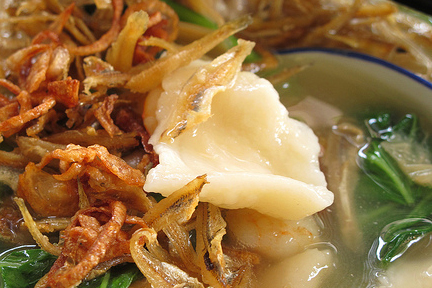Banmian (板麵) is a popular noodle dish, consisting of handmade noodles served in soup.
The name banmian (board/block noodle) came from the Hakka's method of cutting the noodle into straight strands using a wooden block as ruler. In Hakka, some might call it Man-Foon-Char-Guo (麵粉茶粿) or Dao-Ma-Chet (刀嬤切).
In Hokkien, it was called Mee-Hoon-Kueh (麵粉粿; lit. "wheat snack") but what we can find at hawker stalls is generally called banmian. The current style is a mix between the Hakka traditional method and the Hokkien traditional method. The Hakka initially made the noodle by shaving off a dough, whilst the Hokkien would roll the dough into a flat piece then hand-tear into bite-size.
Banmian is a culinary dish that is popular in China, Malaysia, and Singapore. It consists of egg noodles served in a flavorful soup, often with some type of meat or fish, vegetables and various spices. The meal is considered one of the healthier food choices and can be found for sale by restaurants, street vendors and food stalls in the region. The base of the entire meal is a soup, so there are numerous variations in ingredients, stocks and noodle shapes. In many instances, the completed soup is topped with an egg that is cooked in the hot liquid above the noodles.
Most versions of banmian use egg noodles that are simply a blend of egg, flour, water and salt that is kneaded and then formed into noodles. However, the modern day banmian is mainly made by using a pasta maker which cuts noodles in all sizes. It is a highly economical dish and you can cook your own at home because it is a fairly easy process.
The base of the soup can be water but is more commonly a type of fish stock. Normal fish stock can be used, but anchovy stock is a common choice. Various ingredients, such as onions, garlic, ginger and bean paste, also can be added to the stock to provide more flavor, although some preparations are so simple that nothing more than plain stock is used. In Malaysia, you can also try the dried version with soup served separately.
Two common ingredients that are often found across different versions of banmian are mushrooms and anchovies. The exact type of each might vary, but they are generally added to the stock base. The mushrooms can be dried and are reconstituted in the broth, while the anchovies could be fried until crispy and then served on top of the soup. The anchovies also can be added to the stock for flavor and allowed to break down as it cooks.
Once the base stock is completed, nearly anything can be added to complete the banmian. This includes vegetables such as green onions, spinach, cabbage and bamboo shoots. Some vinegar is usually added, occasionally with sugar to balance the flavor. Restaurants may offer minced pork that has been fried or chunks of white fish to act as a protein-rich addition to the soup. Finally, an egg is cracked into the hot broth and allowed to cook until the whites are set and the yolk is warmed through. (wikipedia)

- China Whampoa Home Made Noodle - Whampoa Drive Makan Place #01-24
- China Whampoa Home Made Noodle - 258 Geylang Lorong 12
- L32 Self Made Noodle - 558 Geylang Road
- Top 1 Home Made Noodles - Beauty World Food Centre #04-44
- Qiu Rong Ban Mian - Old Airport Road Food Centre #01-30
- Boon’s Noodles – Mee Hoon Kueh 面粉粿 - Golden Mile Food Centre #01-86
- Mian Zhuang - Hong Lim Food Centre #01-51
- Jiak Song Mee Hoon Kway - Telok Blangah Crescent Food Centre #01-108
- Grandma Ban Mee 老妈子板面 - Amoy Street Food Centre #01-07
- Madam Leong Ban Mian - Amoy Street Food Centre #02-109
- Bossi Ban Mian - Serangoon Garden Food Centre #01-18
